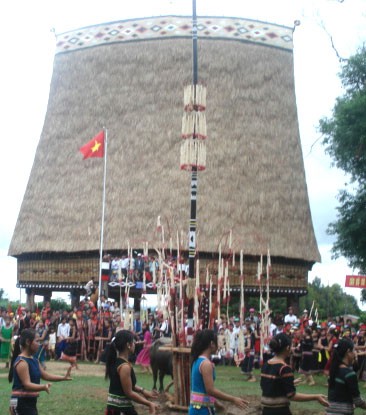(VOVworld) – The Brau or Brao is one of the 5 smallest ethnic groups of the Vietnamese nation. With a population of more than 400, the Brau community primarily lives in the valleys of Se San and Nam Khoong Rivers of the central highlands.
The Brau used to live in the common border area between Vietnam, Laos and Cambodia. In the process of relocation, the Brau people were the latest settlers in Vietnam, about 100 years ago. They don’t have their own alphabet but do have their own mother tongue, which belongs to the Mon Khmer language of the South Asia system. The Brau currently live in Dak Me of Bo Y commune, Ngoc Hoi district, Kon Tum province. This ethnic group believes that the universe is created by Pa Say God who also creates life and death. Like other ethnic groups in the Central Highlands, the Brau people consider living beings tangible and the world of multiple gods: the god of mountains, river, sea, and trees. There is a matriarchal family system. Researcher of ethnic groups in the Central Highlands Luu Anh Hung says: “The traditional culture of the Brau is similar with those in the central highlands, particularly north central highlands. They have Rong communal houses, wooden houses, and festivals associated with rice growing cycle. According to their spiritual beliefs, the Brau champion the role of the gods of paddy, water, soil, forests and mascots. Their musical instruments are the pan-pipe and gongs. Traditionally, the Brau are hospitable and community-spirited, respect the elderly and adore children”.
 |
| Rong communal house in the Central Highlands |
The village structure of the Brau bears communal characteristics. The Rong communal house is the tallest and most beautiful structure and is built in the middle of the village. The locals’ houses are wooden houses facing the Rong house. During Vietnam’s war time, the Brau people lived a nomadic life along the Vietnam-Laos border. After peace was restored, their lives stabilized thanks to the support from the State and border guards. Thao Loi, an official from Dak Me hamlet, Ngoc Hoi district, Kon Tum province, says: “In 2005, the Vietnamese State took concrete measures to help the Brau whose population was shrinking. The government approved a 25 billion VND project to support Brau ethnic group in Bo Y commune. The State invests in local infrastructure, production, building Rong communal house and toilets, connectivity to the national electricity grids, culture and education. A review report in 2010 acknowledged the development of the Brau ethnic group”.
The State also helps locals in seeds and seedling development, wet rice cultivation techniques and the development of coffee and rubber. By the end of 2012, the Brau population increased to 417 from 368 in 2005. Dak Me village and Bo Y commune have decent roads, schools, and kindergartens.
In the following editions, we will continue to tell you about the Brau’s customs, traditions, arts, architecture and music. Stay tuned!